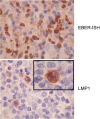Deciphering the role of Epstein-Barr virus in the pathogenesis of T and NK cell lymphoproliferations
- PMID: 21899744
- PMCID: PMC3180299
- DOI: 10.1186/2042-4280-2-8
Deciphering the role of Epstein-Barr virus in the pathogenesis of T and NK cell lymphoproliferations
Abstract
Epstein-Barr virus (EBV) is a highly successful herpesvirus, colonizing more than 90% of the adult human population worldwide, although it is also associated with various malignant diseases. Primary infection is usually clinically silent, and subsequent establishment of latency in the memory B lymphocyte compartment allows persistence of the virus in the infected host for life. EBV is so markedly B-lymphotropic when exposed to human lymphocytes in vitro that the association of EBV with rare but distinct types of T and NK cell lymphoproliferations was quite unexpected. Whilst relatively rare, these EBV-associated T and NK lymphoproliferations can be therapeutically challenging and prognosis for the majority of patients is dismal. In this review, we summarize the current knowledge on the role of EBV in the pathogenesis of these tumours, and the implications for treatment.
Figures



References
-
- Rickinson AB, Kieff E. In: Fields Virology. 5. Knipe DM, Howley PM, editor. Vol. 2. Philadelphia: Lippincott, Williams & Wilkins; 2007. Epstein-Barr virus; pp. 2655–2700.
Grants and funding
LinkOut - more resources
Full Text Sources

